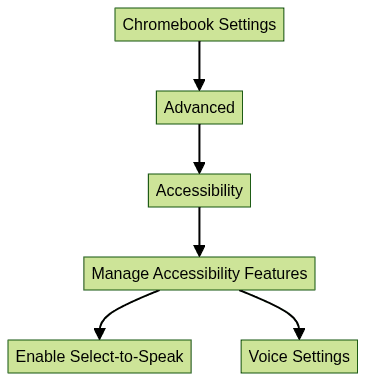How to Turn On Text to Speech: Complete 2025 Guide for Android, Chromebook, Kindle, Google Docs, and More
A comprehensive step-by-step guide on how to turn on text to speech (TTS) technology across major platforms—Android, Chromebook, Kindle, Google Docs, Discord—covering setup, troubleshooting, and customization for developers and tech users in 2025.
Introduction
Text to speech (TTS) technology has transformed the way we interact with digital content, making information more accessible and convenient than ever before. Whether you’re a developer, a power user, or someone seeking accessibility solutions, knowing how to turn on text to speech is an essential skill in 2025. TTS allows devices to convert written text into spoken words, unlocking opportunities for multitasking, productivity, and assisting users with visual impairments. This blog post will walk you through enabling TTS on various platforms including Android, Chromebook, Kindle, Google Docs, and Discord, along with advanced customization, troubleshooting, and privacy considerations.
What is Text to Speech and How Does It Work?
Text to speech (TTS) is a technology that converts digital text into natural-sounding spoken audio. At its core, TTS systems use linguistic algorithms and voice synthesis engines to analyze, process, and vocalize textual input. Modern TTS solutions leverage deep learning models and neural networks to deliver highly intelligible, human-like voices. Common use cases include screen readers for the visually impaired, hands-free document review, language learning tools, and accessibility features within software and operating systems. For developers interested in integrating advanced voice capabilities, solutions like
Voice SDK
can provide powerful APIs for real-time audio experiences.Benefits of Turning On Text to Speech
Turning on text to speech brings a range of benefits:
- Accessibility: TTS is indispensable for visually impaired users, offering them independence in consuming digital information.
- Productivity: It enables developers and users to listen to documentation, emails, or articles while multitasking.
- Language Learning: TTS aids in mastering pronunciation and comprehension in new languages.
- Reading Automation: Automates reading of long texts, coding tutorials, or messages, saving time and reducing eye strain.
If you’re building communication apps, consider using an
android video and audio calling sdk
to add both TTS and real-time interaction features to your Android projects.How to Turn On Text to Speech on Android Devices
Android’s robust TTS engine is highly customizable and supports numerous languages and voices. Here’s how to activate and personalize TTS on your Android device in 2025.
Step-by-Step Guide
- Open Settings: Launch the Settings app on your Android device.
- Accessibility Settings: Navigate to
Accessibility>Text-to-Speech Output. - Select Preferred Engine: Choose your TTS engine (Google Text-to-Speech is standard, but other engines are available).
- Configure Language, Rate, and Pitch: Adjust language, speech rate, and pitch to suit your preferences.
- Install Voice Data: Download additional voices or languages if necessary.

For developers looking to build real-time audio features into Android apps, exploring
webrtc android
can help you leverage WebRTC technology for seamless communication and TTS integration.Troubleshooting Common Android TTS Issues
- No Sound: Check device volume and ensure TTS is enabled. Restart the device if needed.
- Missing Voices/Languages: Download missing voice data from the TTS settings panel.
- Language Issues: Ensure the selected language matches the installed voice data. If issues persist, clear the TTS engine cache or reinstall the engine.
If you want to add calling features alongside TTS, a
phone call api
can help you implement high-quality audio calling in your mobile apps.How to Enable Text to Speech on Chromebooks
Chromebooks offer built-in TTS features to enhance accessibility and productivity. Follow these steps to activate and customize TTS on your Chromebook.
Step-by-Step: Chromebook TTS Setup
- Open Chromebook Settings: Click the clock in the lower right, then the gear icon to access
Settings. - Navigate to Accessibility: Scroll to
Advanced>Accessibility>Manage accessibility features. - Enable Select-to-Speak: Toggle on
Enable Select-to-Speakto allow text selection for speech. - Change Voices/Languages: Under
Text-to-Speech voice settings, select your preferred voice and language.

If you’re building browser-based communication tools, a
javascript video and audio calling sdk
can help you integrate both TTS and live calling features directly into your web apps.Tips for Customizing TTS on Chromebook
- Natural Voices: Install additional voices for more natural speech.
- Voice Data: Download enhanced voice data for higher quality.
- System Language: Ensure your system language matches your TTS preferences for optimal compatibility.
Turning On Text to Speech in Google Docs
Google Docs leverages ChromeVox and other accessibility integrations for TTS support:
- ChromeVox Extension: Install ChromeVox from the Chrome Web Store for screen reading in Docs.
- Accessibility Settings: In Google Docs, go to
Tools>Accessibility settingsand enableTurn on screen reader support. - Document Reading: Select text and use a compatible TTS extension or ChromeVox to have content read aloud, useful for proofreading and accessibility.
For teams looking to quickly add communication features, an
embed video calling sdk
allows you to integrate video and audio calls into collaborative platforms like Google Docs.How to Activate Text to Speech on Kindle Devices
Kindle devices, especially Kindle Fire tablets and select eBooks, offer native TTS features:
- Kindle Fire: Go to
Settings>Accessibility>Text-to-Speech, then toggle TTS on. - Supported eBooks: Tap the screen, select the menu, and choose
Text-to-Speechif available (not all eBooks support TTS due to publisher restrictions). - Limitations: TTS is not available on all Kindle e-readers and some eBooks. Check content compatibility before relying on TTS.
If you want to build live audio experiences similar to Kindle’s TTS, consider using a
Voice SDK
to create interactive audio rooms or reading sessions.Using Text to Speech on Discord
Discord provides TTS commands for both users and server admins:
- TTS Command: Type
/tts your messageto send a TTS message in a text channel (if enabled). - User Settings: Go to
User Settings>Notifications>Text & Images> EnableAllow playback and usage of /tts command. - Server Settings: Server admins can enable or restrict TTS in
Server Settings>Roles.
For developers interested in building Discord-like voice features, a robust
Voice SDK
can help you add real-time audio chat to your own platforms.Advanced TTS Settings and Customization
Text to speech engines offer deep customization via system settings and APIs:
- Adjust Voice, Rate, Pitch: Tweak parameters for more natural or robotic voices.
- Install Additional Voices: Download and install new languages or premium voices.
- Programmatic Control: Use platform APIs to integrate and control TTS in your apps.
If you’re looking to build advanced voice features, integrating a
Voice SDK
can provide flexible APIs for live audio and TTS in your applications.Example: Android TTS API Usage
1TextToSpeech tts = new TextToSpeech(context, status -> {
2 if (status == TextToSpeech.SUCCESS) {
3 int result = tts.setLanguage(Locale.US);
4 tts.setSpeechRate(1.0f);
5 tts.setPitch(1.0f);
6 tts.speak("Hello, world!", TextToSpeech.QUEUE_FLUSH, null, null);
7 }
8});
9Privacy and Security Considerations with TTS
Text to speech features often process data locally, but some advanced voices or cloud-based engines may send text to remote servers. Review privacy settings, use local-only engines when privacy is critical, and avoid inputting sensitive information into cloud TTS services.
Conclusion and Next Steps
Text to speech technology is a powerful tool for accessibility, productivity, and automation in 2025. With support across major platforms like Android, Chromebook, Kindle, Google Docs, and Discord, enabling and customizing TTS is easier than ever. Explore these features to enhance your workflow, improve accessibility, and unlock new ways of interacting with technology.
Ready to experience the latest in real-time voice and video technology?
Try it for free
and start building your own TTS and communication solutions today!Want to level-up your learning? Subscribe now
Subscribe to our newsletter for more tech based insights
FAQ